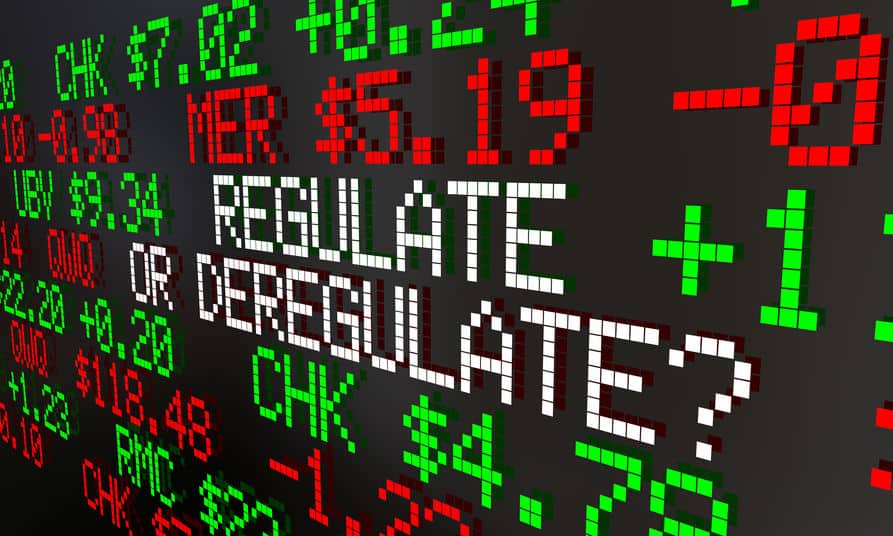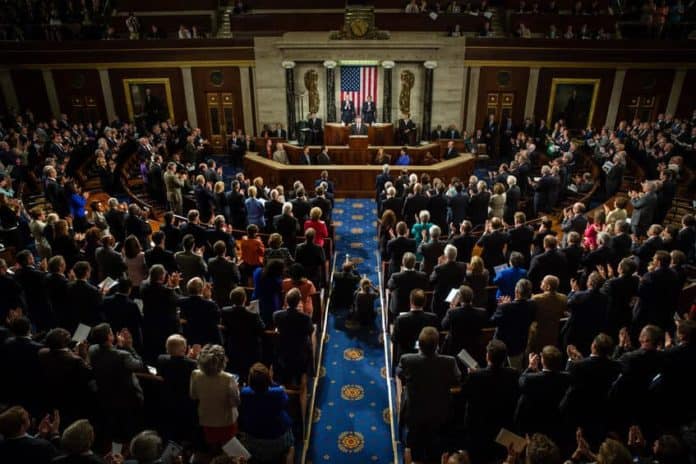In the wake of the 2008 economic crisis, the majority of experts looked at the lack of regulation of U.S. banks and financial institutions as a major reason for the global crisis. A number of solutions were sought under the leadership of the Obama Administration in the U.S. resulting in the passing of the Dodd-Frank Wall Street Reform and Consumer Protection Act being passed into law. Introduced in 2010, the act has been seen as positive by the majority of experts but a number of amendments have been made to the legislation that remains under threat from conservative lawmakers and Wall Street executives.
Why was Dodd-Frank introduced?
The Dodd-Frank Act was introduced in 2010 in response to the global financial crash of 2008 and followed closely along the lines of the Glass-Steagall Act introduced following the Great Depression starting in 1929. Despite claims by many financial institutions and experts of a lack of knowledge of the crisis prior to the events of 2008, many financial leaders point to the repeal of Glass-Steagall in 1999 as one of the main reasons for the 2008 crisis.
Democrat Senator Christopher J. Dodd and House Representative Barney Frank introduced the Bill in 2010 following months of negotiations about how to regulate banks and financial institutions. One of the main regulations within the Glass-Steagall Act was the restriction placed on banks and credit providers regarding the use of deposited fu8nds from investors in unregulated markets. Coupled with the subprime lending market, the use of unlimited funds from depositors in derivative markets was blamed by many for the 2008 economic collapse. The idea behind the Dodd-Frank Act was to develop a set of regulations that would not allow the financial markets to reach a point where the 2008 economic crash could be repeated.

Banks are too big to fail
One of the problems identified by lawmakers and financial experts following the 2008 economic crash was the development of a number of banks deemed too big to fail. To make sure the banks of the U.S. were not operating at a level that would provide potential issues for the economy as a whole, the Financial Stability Oversight Council was given wide-ranging powers. The nine members of the council are headed by the Treasury Secretary who is tasked with making sure all banks and financial institutions are in a healthy position regarding their cash on hand to avoid bankruptcy.
Among the steps that can be taken by the Financial Stability Oversight Council is the ability to force a bank to increase its reserves to ensure enough cash is at hand to handle their responsibilities. One of the main problems identified by the Dodd-Frank Act was the development of banks that were so large their failure would impact the entire U.S. economy. Dodd-Frank keeps all banks under constant monitoring with the development of those who grow so large they are deemed as too big to fail no longer allowed. In the case of those banks growing to giant size, the FSOC has the power to break up banks that are deemed too large by the Council.
Halting the subprime lending market
One of the main stories to come out of the 2008 economic crash was the huge number of lenders who were misselling loans, mortgages, and credit cards to consumers without explaining the consequences. To combat this subprime and misleading part of the lending market, Dodd-Frank established the Consumer Financial Protection Bureau that was charged with the job of overseeing these markets.
One of the biggest complaints from those who were sold various credit-based products was the fact individual consumers believed they were told the true significance of their loan upon it being created. The Dodd-Frank Act established new rules regarding the need for easy to understand information regarding the requirements of a mortgage and other loan repayments was designed to limit the number of cases of those who were unsure of their responsibilities for repaying their loans. The Consumer Financial Protection Bureau was also given the role of watchdog with the responsibility of handling consumer complaints regarding mortgages, credit cards, and other financial products involving lines of credit.
Insurance companies are also being monitored
One of the main concerns among the news media during the 2008 economic meltdown was that of the subprime lending market. However, the insurance markets also played a role in the 2008 economic crisis and were included in the developed regulations of Dodd-Frank. We often look at the role of AIG, American International Group in the 2008 economic meltdown as contributing to the problems experienced. The Treasury Department’s Federal Insurance Office reports on individual insurance companies it feels are growing too large or are facing financial difficulties in the future. The same office also monitors the entire insurance market and provides regular updates to the Treasury to ensure the surprise of 2008 is never repeated.
Installing The Volcker Rule
The Volcker Rule was included in the Dodd-Frank Act as a return to the tough regulations of the 1933 Glass-Steagall Act that was only repealed in 1999. The Volcker Rule is a simple one that basically makes it illegal for any bank or financial institution to gamble with funds from their investors using risky global markets.
Many experts believe that as the 2008 economic crisis loomed, banks and investment firms became more willing to gamble on risky markets where the rewards were large but losses could be devastating. Removing the restrictions of the Glass-Steagall Act in 1999 allowed banks to change their entire approach to trading in the early-21st-Century. Before the repeal of Glass-Steagall, banks could not trade solely for profit but had to consider the effects on the profits of their investors and depositors. The Volcker Rule basically outlaws risky trading and proprietary trading solely for profit by banks and other financial institutions.

Monitors Federal Reserve bailouts
One of the most controversial reactions to the 2008 economic crisis in the U.S. was the huge number of bailouts provided by the Federal Reserve to banks, automakers, and other industries affected negatively by the events. Many critics believe the Federal Reserve overstepped its boundaries when it provided financial bailouts to many of the biggest banks and insurance companies in the U.S.
To make sure the Federal Reserve does not overstep the mark in the future, the Government Accountability Office works alongside the Treasury Department to ensure any future emergency loans are approved at all levels. Perhaps the most important aspect of the work of the Government Accountability Office is to release the names of all banks and financial institutions who receive loans are released to the public.
Making sure credit ratings are accurate
An area of the financial industry that came in for the most criticism in 2008 was that of the credit rating bureaus. These companies are charged with the important job of providing ratings for banks, financial institutions, and governments around the world. The lack of panic in the months and years prior to 2008 was seen by many of a failure to act effectively by these credit agencies. The SEC Office of Credit ratings has been established by Dodd-Frank to work closely with agencies such as Moody’s and Standard & Poor’s to ensure their reporting is accurate.
Whistle-blowers are being protected
The practices of employees and managers at banks and financial institutions across the U.S. were seen as risky and often bordering on the illegal during the slide to the 2008 economic crisis. Whistle-blowers were rarely heard from and those who were often faced major reprisals from their employers who effectively blacklisted them from working in the financial industry again. The Dodd-Frank Act includes greater protections for those who are now attempting to shed light on the financial mishandling that could lead to a future economic crash.
Not only are the identities of whistle-blowers protected in the post-2008 financial landscape, but those who choose to notify the authorities of unlawful behavior cannot be revealed to their employers. The Dodd-Frank Act also tried to make it more rewarding for whistle-blowers to take part in proceedings by providing them with between 10 and 30 percent of any financial settlement achieved by U.S. Government agencies because of their information.
Changes for small banks
After being introduced in 2010, the Dodd-Frank Act did face some criticism from financial experts and members of the banking industry for the restraints placed on the smaller and regional banks of the U.S. Among those who battled for fewer restriction included the Ally Bank and Barclays who believed the restrictions placed on making risky investments on the hedge fund markets and derivative trading placed them at a disadvantage to larger institutions. In May 2018, the U.S. Congress made some changes to the Dodd-Frank Act designed to allow smaller and regional banks a little more freedom to work on behalf of their investors. The changes included banks holding between $100 billion and $250 billion in assets are no longer required to comply with the requirements of the Volcker Rule and can make risky trades on behalf of their investors.
Congress passed the Economic Growth, Regulatory Relief and Consumer Protection Act in 2018 which made a series of changes to the Dodd-Frank Act without completely repealing it. The impact on small and regional banks was seen as the most important and led to the U.S. placing only 12 banks as needing to comply with all aspects of the legislation from 2010. Banks and institutions with less than $250 billion in assets are no longer required to pass the “stress tests” of the Treasury Department as they are not classed as too big to fail.
The changes made in 2018 have raised fears among some financial experts that the climate is returning to that which led directly to the problems of 2008. The subprime lending market had been eliminated and those still involved were restricted in their dealing by Dodd-Frank. The 2018 legislation removed the escrow requirements on mortgage lenders introduced by Dodd-Frank were removed in some circumstances to ease the problems of providing loans to those with lower credit scores. Smaller lenders were also included in the relaxation of the rules regarding the Volcker Rule and relaxed the level of reporting needed to remain compliant with the federal agencies in charge of lending.

The benefits of the Dodd-Frank Act
There have been a few areas where the Dodd-Frank Act can be seen as benefiting the U.S. financial sector as a whole and positively impacting the public. Among the clear benefits of the introduction of the Act are the limitations placed on banks becoming involved in hedge fund trading. It is often unclear what a hedge fund is trading in and its clear objectives in recent years because of the complex nature of the market. The greater levels of reporting and oversight have also been hailed as benefits of the Dodd-Frank Act as the ability of the public and government agencies to monitor the financial health of individual banks and the markets as a whole.
Protecting consumers has undoubtedly been one of the most important aspects of the introduction of the Dodd-Frank Act that has now been limited in its reach. The creation of the Consumer Financial Protection Bureau remains at the top of the impressive list of achievements of the legislation as a watchdog provides confidence for the general public.
Removing the ability of large banks and financial institutions to take part in proprietary trading is seen as another key advantage of the Dodd-Frank Act. This risky form of trading is seen as one of the key factors leading to the 2008 economic meltdown because of the risky nature of this process. Although many large banks feel they can no longer make large profits the confidence of consumers has been increased with the knowledge their funds can no longer be used for the gain of the bank and not themselves.
Can Dodd-Frank by repealed?
Since the introduction of the Dodd-Frank Act, it has been clear many conservatives are looking to repeal many of the different aspects of the regulations on the financial sector. Repeal has often been placed on the table by many politicians but the repeal of the Act becomes more and more unlikely the longer Dodd-Frank is in place. Many experts now believe any repeal would be ineffective because if the spread of regulations through financial institutions around the world.
Instead of looking to repeal the regulations of Dodd-Frank, the major impact on the regulations have been made with the introduction of a series of policies designed to impact the law negatively. Most experts agree with the introduction of the Consumer Financial Protection Bureau as one of the most impressive parts of the legislation. However, the power of the office has been proven to be limited by executive leaders who can affect policy decisions regarding the future of the office.
For the majority of conservatives and some Democrats in Congress, the need for Dodd-Frank has been eliminated with the switch by most consumers and small business owners to smaller lenders instead of the larger banks. With the majority of lending now coming from smaller banks and credit unions, those on the right and many on the left believe the restrictions of Dodd-Frank are no longer required. The removal of Dodd-Frank from the laws of the U.S. would return the financial markets to their position prior to 2008 when the U.S. Government had little to no power to impact the slide of the economy towards depression. Without the restrictions and reporting requirements of Dodd-Frank, the chances of another depression taking place would be greatly increased but not necessarily inevitable.












